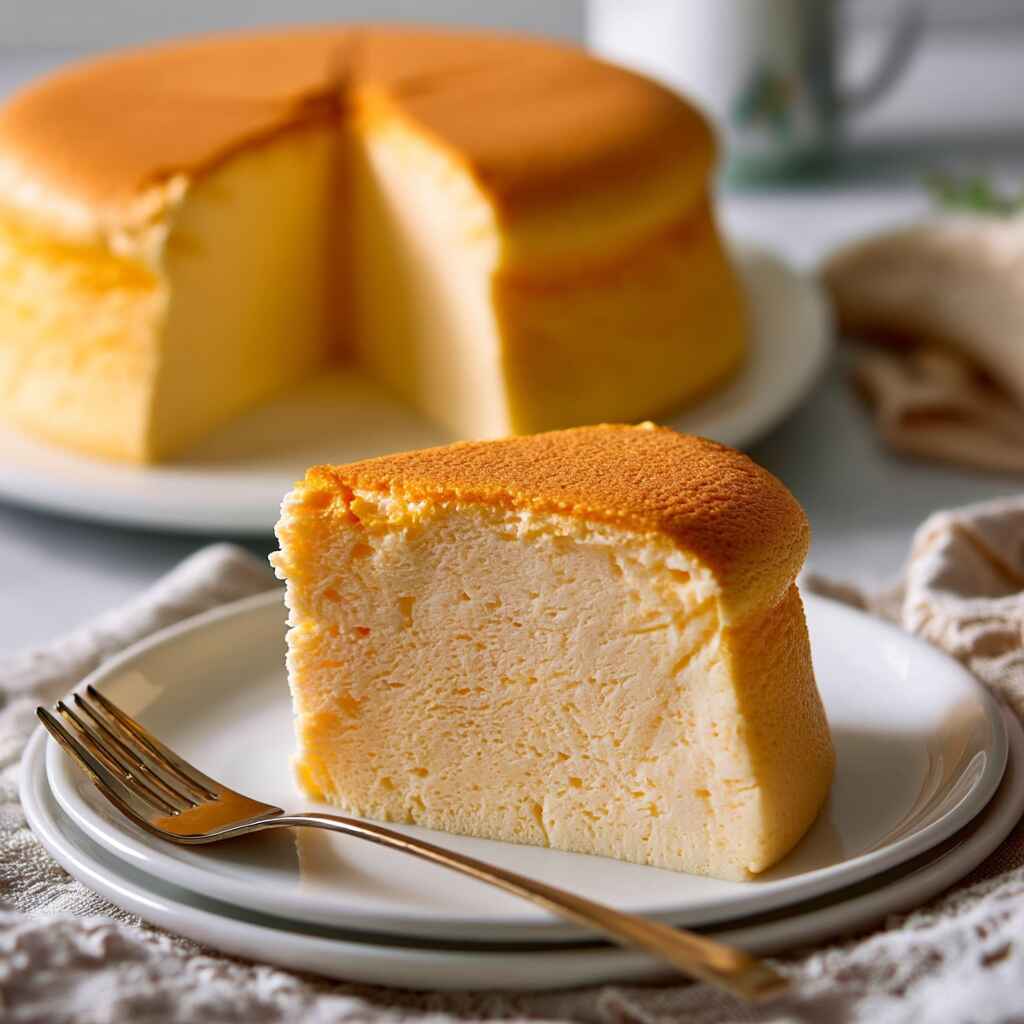The first time I tasted Japanese cotton cheesecake, I thought it might float off the plate. Unlike the heavy, rich cheesecakes I grew up with, this one was delicate light as a sigh, warm like memory. It melted on the tongue, whispering sweetness and comfort with every bite. But recreating that texture at home? It felt impossible until I learned the secrets. Whether your last cheesecake collapsed or turned dense and rubbery, this guide is for you. Let’s bring the cloud down to earth, one soft, pillowy slice at a time with this foolproof Japanese cotton cheesecake.
Why This Japanese Cotton Cheesecake Always Works Even for Beginners
Baking a Japanese cotton cheesecake feels like learning a quiet kind of patience. It’s not just about ingredients it’s about how you treat them. Every step in this recipe is designed to guide you with care, especially if you’ve had cheesecakes sink or crack before.
The double boiler ensures the cream cheese melts gently no lumps, no scorched edges. That slow melt is where the softness begins. Then, the meringue comes in like a breath of air firm peaks that fold into the batter like silk. No rush. No noise. Just a soft whisk and a steady hand.
This method gives you a cake that’s tender but holds its shape airy, but not dry. Baking in a water bath cushions the cake in moisture and warmth. The gentle oven rise prevents cracks, and the final temperature boost browns the top just enough without shocking the structure.
If you’ve fallen in love with cheesecake before, you might also enjoy our Tiramisu Cheesecake creamy, moody, and rich with espresso layers.
And for something more classic and comforting, the Classic New York Cheesecake has its own charm bold, dense, and unapologetically indulgent.
The Japanese version, though it’s like a whisper of sweetness. A quiet comfort on a cloudy afternoon. One you’ll want to make again and again.
Your Foolproof Guide to the Softest Japanese Cotton Cheesecake
This cake isn’t forgiving if you rush but it rewards you deeply when you don’t. From pan prep to folding technique, here’s how to set yourself up for cloud-soft success.
Ingredient List with Substitutions
| Ingredient | Amount | Notes & Substitutions |
|---|---|---|
| Cream cheese | 160g | Use block-style, full-fat (e.g., Philadelphia) |
| Unsalted butter | 20g | Adds richness don’t substitute |
| Whole milk | 60g | Full-fat only for moisture |
| Cake flour | 30g | Soft, low-protein flour ensures lightness |
| Corn flour | 1 tbsp | Also called cornstarch |
| Salt | Pinch | Balances sweetness |
| Egg yolks | 3 | From large eggs (60g each with shell) |
| Egg whites | 3 | Whipped separately for airiness |
| Cream of tartar | ⅛ tsp | Stabilizes egg whites |
| Caster sugar | 60g | Superfine texture blends better |
Common Mistakes to Avoid
- Cold cream cheese (leads to lumps)
- Overmixed meringue (deflates the rise)
- Lining the pan sides (creates unsightly folds)
- Skipping the water bath (results in cracks)
Pro Tips
- Use a thermometer: Keep cream cheese mixture under 60°C (140°F)
- Tap the pan before baking to remove bubbles
- Only line the bottom of your cake pan
- Use a tea towel under the pan for even baking
Nutrition Highlights
| Nutrient | Per Serving |
|---|---|
| Protein | 7g |
| Carbs | 12g |
| Fat | 6g |
Foolproof Step-by-Step Instructions
- Preheat: Oven to 120°C (248°F), rack in lower-middle position.
- Boil water for the water bath; you’ll need at least 1 inch.
- Grease pan sides completely and line only the bottom.
- Melt base ingredients (cream cheese, butter, milk) in a double boiler. Stir until smooth.
- Add dry ingredients (sifted) and mix until just combined.
- Stir in yolks, one at a time. Then strain the mixture.
- Make meringue: Whip whites, sugar, and tartar to glossy firm peaks.
- Fold meringue in thirds into cheese mixture gently.
- Pour into pan, run skewer through to remove air, tap the pan.
- Bake in a hot water bath: 110°C (230°F) for 60 min → then 160°C (320°F) for 15 min.
- Cool inside oven (door cracked) for 10 min before removing.
- Invert carefully, let cool on rack.
Want something cozy and fall-inspired? Our Pumpkin Cream Cheese Bread carries the same warm richness in loaf form.
How to Serve, Store & Savor Japanese Cotton Cheesecake
How to Serve Japanese Cotton Cheesecake
When the cheesecake is fully cooled, the first slice always feels sacred. Use a warm, sharp knife to cut through gently wipe between cuts for those clean, photo-worthy slices. This cake is best served at room temperature where its delicate bounce and airy crumb shine.
You can dust it with powdered sugar or top with a thin swipe of whipped cream, but honestly, it doesn’t need much. I love it with nothing more than a cup of hot hojicha or chamomile tea. It’s quiet food. It comforts without demanding.
If you’re hosting a brunch or afternoon tea, this pairs beautifully with something spiced, like our Cinnamon Roll Cake the contrast of rich and light is deeply satisfying.
How to Store
Let the cheesecake cool fully before storing never refrigerate while warm. Wrap it gently in parchment, then plastic wrap or a lidded container. It keeps well in the fridge for up to 4 days. The texture stays light, though slightly firmer on day two, which some people love even more.
Can You Freeze Japanese Cotton Cheesecake?
Yes, you can. Slice and wrap individual pieces in parchment and place them in a freezer-safe container. Thaw in the fridge overnight, then let sit at room temperature for 30 minutes before serving. It loses a bit of its bounce but keeps its flavor especially comforting on a chilly evening.
Our Loaf Cake also freezes beautifully, if you’re planning ahead for holiday gifting or quiet mornings.
Some recipes stay with you not because they’re the fanciest or the most dramatic, but because they feel like home. This Japanese cotton cheesecake became that for me. A quiet ritual. A slice of stillness in a loud world.
FAQ SECTION
1. What does Japanese cotton cheesecake taste like?
Japanese cotton cheesecake tastes like a cross between a souffle and a cheesecake. It’s lightly sweet, soft as a cloud, and melts on the tongue. Unlike dense American cheesecakes, this version feels weightless pillowy, tender, and gently creamy without being rich. Some describe it as the cheesecake version of angel food cake, but with more depth.
2. What’s the difference between a regular cheesecake and a Japanese cheesecake?
The biggest difference is texture. A regular cheesecake is dense, rich, and heavy, often baked without flour and with a crumb base. Japanese cotton cheesecake uses whipped egg whites (meringue), cake flour, and a water bath to create a light, airy structure. It juggles softness and structure delicately. There’s no crust, and the flavor is more subtle, letting the cream cheese whisper rather than shout.
3. What is Japanese cotton cheesecake?
Japanese cotton cheesecake is a fluffy, jiggly dessert made from cream cheese, eggs, and a small amount of flour. It’s inspired by Western cheesecakes but reimagined with a Japanese sense of lightness and balance. It’s typically steamed in a water bath and served with minimal decoration letting the texture be the star. This is the kind of cake you eat slowly, maybe with memories.
4. Why does Japanese cheesecake taste different?
Japanese cheesecake tastes different because it uses whipped egg whites and is baked low and slow in a water bath. This method makes it airy and moist without being overly sweet or heavy. There’s no graham cracker crust, no sour cream topping just a pure, creamy essence that feels like a dessert you dreamt into being.
CONCLUSION
Some desserts feed the body. Others feed the spirit. This Japanese cotton cheesecake does both.
It’s not just soft it’s quiet. It doesn’t shout for attention. It waits for you. One slice, one breath, one slow bite at a time. Whether you’re baking for comfort, memory, or someone you miss, let this be your gentle ritual.
If this recipe reminds you of someone you love, share it with them. Your memories keep recipes alive.
Recipe written by Redondo – from our kitchen to yours.
Japanese Cotton Cheesecake
Ingredients
Equipment
Method
- Preheat oven to 120°C (248°F). Prepare water bath with 1 inch of boiling water.
- Grease sides of a 6×3 inch cake pan, line only the base with parchment paper.
- Melt cream cheese, butter, and milk in double boiler until smooth. Remove and cool slightly.
- Sift in flour, corn flour, and salt. Mix gently. Add yolks one by one. Strain mixture.
- Whip egg whites, cream of tartar, and sugar to firm glossy peaks.
- Fold meringue into cream cheese base gently. Pour into pan, tap to remove air bubbles.
- Place pan into water bath. Bake at 110°C (230°F) for 60 mins, then 160°C (320°F) for 15 mins.
- Turn off oven, let cake rest inside 10 minutes with door cracked. Remove and unmold carefully.

